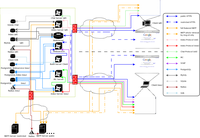It was a nice conference, the guys and gals from Netways surely know how to run an event. It's all the nice little details which make up a great experience.
I was also surprised by NH Hoteles, the Nuremberg City one greeted us with one of the most attractive parking garages I've ever seen (_very_ clean, "follow me"-lines on the floor, automatic hinged safety doors, complimentary window cleaning for hotel guests, etc.) and the hotel lived up to the standards it set in it's garage ;). The only problem I noticed was that the dining area was constantly understaffed for the 70-something people which attended the conference.
The lineup of the conference was quite nice although I prefer "war stories" told from real world scenarios over feature presentations of a single solution. Fortunately Kristian Köhntopp was able to speak about his experiences from his times as a MySQL consultant and the stuff he's doing over at booking.
More on that after the break.
- Everything planned & communicated in advance, no uncertainties on what/how/where
- Taped down cables everywhere
- Enough power sockets for laptops and other gadgets in every conference room and the lounge area
- Nameplates on the speakers podests
- Constantly refilled/replaced bottles & glasses
